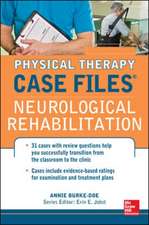Parkinson's Disease and Related Disorders: Journal of Neural Transmission. Supplementa, cartea 70
Editat de Peter Riederer, Heinz Reichmann, Moussa B. H. Youdim, Manfred Gerlachen Limba Engleză Hardback – 23 aug 2006
This book gives a comprehensive overview on current clinical and basic research issues related to Parkinson’s disease and its related disorders and is suitable for neurologists, psychiatrists, neurosurgeons, basic researchers, geneticists and patients as well as their relatives.
Din seria Journal of Neural Transmission. Supplementa
- 5%
 Preț: 1052.64 lei
Preț: 1052.64 lei - 5%
 Preț: 423.12 lei
Preț: 423.12 lei -
 Preț: 389.88 lei
Preț: 389.88 lei - 5%
 Preț: 360.86 lei
Preț: 360.86 lei - 5%
 Preț: 712.60 lei
Preț: 712.60 lei - 5%
 Preț: 365.61 lei
Preț: 365.61 lei -
 Preț: 379.68 lei
Preț: 379.68 lei - 5%
 Preț: 376.43 lei
Preț: 376.43 lei -
 Preț: 380.45 lei
Preț: 380.45 lei - 15%
 Preț: 665.73 lei
Preț: 665.73 lei - 5%
 Preț: 990.03 lei
Preț: 990.03 lei - 5%
 Preț: 368.73 lei
Preț: 368.73 lei - 5%
 Preț: 373.84 lei
Preț: 373.84 lei -
 Preț: 391.22 lei
Preț: 391.22 lei - 15%
 Preț: 643.34 lei
Preț: 643.34 lei -
 Preț: 381.59 lei
Preț: 381.59 lei - 5%
 Preț: 394.32 lei
Preț: 394.32 lei - 5%
 Preț: 374.78 lei
Preț: 374.78 lei -
 Preț: 397.97 lei
Preț: 397.97 lei - 5%
 Preț: 379.33 lei
Preț: 379.33 lei - 5%
 Preț: 364.33 lei
Preț: 364.33 lei - 5%
 Preț: 372.97 lei
Preț: 372.97 lei - 5%
 Preț: 372.19 lei
Preț: 372.19 lei - 5%
 Preț: 387.02 lei
Preț: 387.02 lei - 5%
 Preț: 1371.76 lei
Preț: 1371.76 lei - 5%
 Preț: 382.06 lei
Preț: 382.06 lei - 5%
 Preț: 367.47 lei
Preț: 367.47 lei - 5%
 Preț: 698.37 lei
Preț: 698.37 lei - 18%
 Preț: 1400.35 lei
Preț: 1400.35 lei - 5%
 Preț: 1315.00 lei
Preț: 1315.00 lei - 5%
 Preț: 1428.71 lei
Preț: 1428.71 lei - 5%
 Preț: 1095.73 lei
Preț: 1095.73 lei - 5%
 Preț: 714.46 lei
Preț: 714.46 lei - 5%
 Preț: 1113.11 lei
Preț: 1113.11 lei - 5%
 Preț: 1015.44 lei
Preț: 1015.44 lei - 5%
 Preț: 719.74 lei
Preț: 719.74 lei - 5%
 Preț: 1304.06 lei
Preț: 1304.06 lei - 5%
 Preț: 1980.23 lei
Preț: 1980.23 lei
Preț: 1381.93 lei
Preț vechi: 1454.66 lei
-5% Nou
Puncte Express: 2073
Preț estimativ în valută:
264.46€ • 287.17$ • 222.15£
264.46€ • 287.17$ • 222.15£
Carte tipărită la comandă
Livrare economică 18-24 aprilie
Preluare comenzi: 021 569.72.76
Specificații
ISBN-13: 9783211289273
ISBN-10: 3211289275
Pagini: 524
Ilustrații: X, 506 p. 75 illus.
Dimensiuni: 210 x 277 x 37 mm
Greutate: 1.59 kg
Ediția:2006
Editura: SPRINGER VIENNA
Colecția Springer
Seria Journal of Neural Transmission. Supplementa
Locul publicării:Vienna, Austria
ISBN-10: 3211289275
Pagini: 524
Ilustrații: X, 506 p. 75 illus.
Dimensiuni: 210 x 277 x 37 mm
Greutate: 1.59 kg
Ediția:2006
Editura: SPRINGER VIENNA
Colecția Springer
Seria Journal of Neural Transmission. Supplementa
Locul publicării:Vienna, Austria
Public țintă
ResearchCuprins
Oleh Hornykiewicz.- Melvin Yahr (1917–2004). An appreciation.- Melvin D. Yahr, 1917–2004. A personal recollection.- Melvin D. Yahr, 1917–2004. A personal recollection.- Pathology.- The discovery of dopamine deficiency in the parkinsonian brain.- Synchronizing activity of basal ganglia and pathophysiology of Parkinson’s disease.- Basal ganglia discharge abnormalities in Parkinson’s disease.- Bad oscillations in Parkinson’s disease.- Cortical muscle coupling in Parkinson’s disease (PD) bradykinesia.- GDNF as a candidate striatal target-derived neurotrophic factor for the development of substantia nigra dopamine neurons.- The engrailed transcription factors and the mesencephalic dopaminergic neurons.- The role of Pitx3 in survival of midbrain dopaminergic neurons.- Genetic analysis of dopaminergic system development in zebrafish.- Striatal plasticity in parkinsonism: dystrophic changes in medium spiny neurons and progression in Parkinson’s disease.- The nigrostriatal DA pathway and Parkinson’s disease.- Relationship between axonal collateralization and neuronal degeneration in basal ganglia.- Pathology associated with sporadic Parkinson’s disease — where does it end?.- Critical appraisal of brain pathology staging related to presymptomatic and symptomatic cases of sporadic Parkinson’s disease.- A short overview on the role of ?-synuclein and proteasome in experimental models of Parkinson’s disease.- The role of protein aggregates in neuronal pathology: guilty, innocent, or just trying to help?.- Iron and neuromelanin.- New face of neuromelanin.- The effect of neuromelanin on the proteasome activity in human dopaminergic SH-SY5Y cells.- Potential sources of increased iron in the substantia nigra of parkinsonian patients.- Iron and Friedreichataxia.- Genetics.- Nongenetic causes of Parkinson’s disease.- Is atypical parkinsonism in the Caribbean caused by the consumption of Annonacae?.- CYP450, genetics and Parkinson’s disease: gene × environment interactions hold the key.- Unique cytochromes P450 in human brain: implication in disease pathogenesis.- Cytochrome P450 and Parkinson’s disease: protective role of neuronal CYP 2E1 from MPTP toxicity.- Nicotine induces brain CYP enzymes: relevance to Parkinson’s disease.- Genetic causes of Parkinson’s disease: extending the pathway.- Progress in familial Parkinson’s disease.- Molecular mechanisms of nigral neurodegeneration in Park2 and regulation of parkin protein by other proteins.- Parkin and defective ubiquitination in Parkinson’s disease.- PINK-1 and DJ-1 — new genes for autosomal recessive Parkinson’s disease.- Clinical and pathologic features of families with LRRK2-associated Parkinson’s disease.- Molecular genetic findings in LRRK2 American, Canadian and German families.- Imaging.- Genetic and DAT imaging studies of familial parkinsonism in a Taiwanese cohort.- Neuroimaging in Parkinson’s disease.- Transcranial sonography in the early and differential diagnosis of Parkinson’s disease.- Models.- How to judge animal models of Parkinson’s disease in terms of neuroprotection.- Limitations of cellular models in Parkinson’s disease research.- The Rotenone model of Parkinsonism — the five years inspection.- Controversies on new animal models of Parkinson’s disease Pro and Con: the rotenone model of Parkinson’s disease (PD).- Proposed animal model of severe Parkinson’s disease: neonatal 6-hydroxydopamine lesion of dopaminergic innervation of striatum.- ?-Synuclein overexpression model.- Kynurenines, Parkinson’s disease andother neurodegenerative disorders: preclinical and clinical studies.- Clinical approaches.- What’s new? Clinical progression and staging of Parkinson’s disease.- Parkinson’s disease: premotor clinico-pathological correlations.- Detection of preclinical Parkinson’s disease along the olfactory trac(t).- The clinical approach to gait disturbances in Parkinson’s disease; maintaining independent mobility.- Getting around and communicating with the environment: visual cognition and language in Parkinson’s disease.- Cardiovascular aspects of Parkinson disease.- Multiple system atrophy and autonomic failure.- Sleep disturbances and excessive daytime sleepiness in Parkinson disease: an overview.- Sleep and wakefulness disturbances in Parkinson’s disease.- Neuroinflammation.- Parkinson’s disease dementia: what’s in a Lewy body?.- Role of microglia in inflammation-mediated degeneration of dopaminergic neurons: neuroprotective effect of Interleukin 10.- Role of cytokines in inflammatory process in Parkinson’s disease.- Neurosurgery.- Surgical therapy for Parkinson’s disease.- Deep brain stimulation for the treatment of Parkinson’s disease.- Deep brain stimulation in Parkinson’s disease patients: biochemical evidence.- Neurosurgery in Parkinson’s disease: the doctor is happy, the patient less so?.- L-Dopa.- Placebo effect and dopamine release.- A new look at levodopa based on the ELLDOPA study.- Thirty five years of experience in the treatment of Parkinson’s disease with levodopa and associations.- Neuroprotection.- Concerning neuroprotective therapy for Parkinson’s disease.- Triggering endogenous neuroprotective mechanisms in Parkinson’s disease: studies with a cellular model.- Ladostigil, a novel multifunctional drug for the treatment of dementiaco-morbid with depression.- M30, a novel multifunctional neuroprotective drug with potent iron chelating and brain selective monoamine oxidase-ab inhibitory activity for Parkinson’s disease.- Involvement of multiple survival signal transduction pathways in the neuroprotective, neurorescue and APP processing activity of rasagiline and its propargyl moiety.- Other treatment strategies.- Anti-apoptotic gene therapy in Parkinson’s disease.- The discovery of the pressor effect of DOPS and its blunting by decarboxylase inhibitors.- Dystonia.- Pathophysiology of dystonia.- Genetics of dystonia.
Caracteristici
Includes supplementary material: sn.pub/extras













